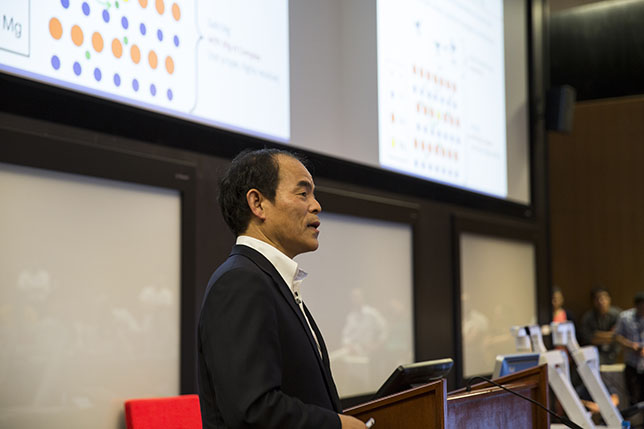KAUST-Nobel Laureate Collaboration Bringing Light to the World

Nobel laureate Shuji Nakamura speaks at KAUST on June 4 to discuss his work in creating blue light-emitting diodes (LEDs).
Boon Ooi, KAUST Professor of Electrical Engineering, Nobel laureate Shuji Nakamura from the University of California, Santa Barbara (UCSB) and a team of researchers from King Abdulaziz City of Science and Technology (KACST) are working to provide energy-efficient lighting to the world.
Through a tripartite agreement begun in 2014, the team works on developing laser-based solid-state lighting (SSL), a type of lighting that may save even more energy than currently used light-emitting diode (LED) lighting.
Solid-state lighting and energy efficiency
SSL is a term broadly referring to semiconductor materials used to convert electricity into light. LED lighting is the dominant type of SSL and consists of layers of semiconductor materials that emit light through a process called spontaneous emission.
LEDs are more energy-efficient than other traditional bulbs, such as incandescent and halogen bulbs, because LEDs convert a large percentage of electrical energy into light, while filament-based light bulbs convert most of the electrical energy into heat and only a small fraction of the energy into light.
“Over 40 percent of the electrical energy going into an LED-based SSL device is converted into visible light,” explains Ooi. “In comparison, a regular incandescent bulb will convert only about 3 percent of the energy into light and the rest into heat. In addition, SSL has a much longer lifespan than traditional lighting, ranging up to 50,000 hours or more for LEDs.”

The KAUST audience, including KAUST President Jean-Lou Chameau, listens to Nobel laureate Shuji Nakamura speaking at the University on June 4.
Blue LEDs and the Nobel Prize in Physics
In 2014, Nakamura, Isamu Akasaki and Hiroshi Amano were awarded the Nobel Prize in Physics for their work in developing blue LEDs, which have been essential in enabling the creation of white LED lights suitable for widespread use. LEDs are not inherently white light-producing devices, and white light production requires either the use of a blue LED to excite yellow phosphor, or a combination of red, green and blue LED lights.
Although red and non-visible near infrared diodes existed, it was much more challenging to create blue ones. Nakamura and his colleagues produced blue LEDs through the use of the semiconductor gallium nitride (GaN), a material that was notoriously difficult to handle at that time.
The future and LEDs
With the advances in LED lighting, LEDs are now in use in parking lots, supermarkets, homes, hotels, office buildings and museums, in devices like flashlights and for signage. However, there are some disadvantages to using LEDs, because above a certain electrical current, they become less efficient and turn less electrical energy into light.
“LED lighting is now moving to the next stage, and we believe this may be semiconductor laser-based SSL,” says Ooi. “In comparison to LEDs, laser diodes are brighter, can operate at higher optical output power and have much higher power efficiencies with comparable cost to LEDs.”

Nobel laureate Shuji Nakamura (L) and KAUST Professor Boon Ooi (R) work together in a collaborative project on laser-based solid-state lighting.
Nakamura and KAUST collaborate
Nakamura and Ooi started working together in 2012 when they ran the first U.S. National Science Foundation (NSF)-funded workshop in the Middle East, which was held at KAUST.
During the workshop, Ooi, Nakamura and participants from around the world “had a chance to really sit down and talk about different ideas, including laser-based SSL,” Ooi says.
Growing GaN
In the current collaboration, the KAUST team works on designing different material structures to make high performance semiconductor lasers. “We have to design the light emitting layer that we call the active layer,” explains Ooi. “Nakamura and his lab grow the laser material structures out of high-quality GaN and its related materials according to our design. Here at KAUST, we then apply nanofabrication techniques on the laser wafer grown at UCSB to convert it into semiconductor laser devices. We also carry out the necessary characterization steps at KAUST and bring the device to the system level applications.”
Different uses for semiconductor lasers
Nakamura, Ooi and the team are excited about their work with semiconductor lasers because of the lasers’ “other advantages and side applications,” Ooi says. Among these are the use of the lasers for visible light communications and underwater communications, and using them to grow indoor plants using red and blue colored lights, thereby saving energy, water and space.
“KAUST and UCSB have already demonstrated that GaN-based lasers can be used to transmit Internet signals with 100 times more data than the present microwave transmission technology,” Nakamura notes.
Saving energy for the world
Ooi hopes that laser-based SSL “will one day replace most of the world’s power-hungry bulbs. I think that LED-based bulbs have another 10-20 years to go, but if LEDs are replaced by semiconductor laser-based bulbs, we will save even more energy.”
Even if the use of semiconductor lasers is not eventually accepted for SSL, Ooi notes, the lasers have many other applications. “We call these lasers a solution looking for a problem – people just have to think about how to use them,” he says.
A fruitful collaboration
“I enjoy the collaboration with Nakamura and his group at UCSB not because I’m working with a Nobel laureate, but because of the science,” Ooi says. “We have a lot of interesting science we work on together, and through our experimental work, we are beginning to see a lot of results, so it has become quite a fruitful collaboration.”
“Through KAUST and UCSB’s complementary expertise in laser-based SSL, many interesting outcomes are sure to result,” Nakamura adds.
- by Caitlin Clark, KAUST News

